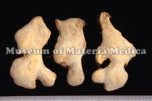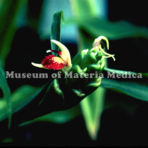Ginger

|
Market name:生姜 Photo location:Museum of Materia Medica, Inst. of Nat. Med. TMPW No.:10656 |

|
Plant name:Zingiber officinale Photo location:Toyama Pref., Japan Photo date:1983 Photographer:H. Fujino |
| Synonym | |
| Latin name | Zingiberis Rhizoma |
| Botanical source: Family name | Zingiberaceae |
| Botanical source: Plant name | Zingiber officinale Roscoe (IPNI:798372-1) |
| Part used | Rhizome |
| Empirical criteria for quality selection | Good one is enlarged and the inside is white in color. It has a strong pungency. Young roots are not good in quality. (TN) |
| Constituents | Other aliphatic and related compounds: Methylheptenone, Nonylaldehyde Monoterpenoids: β-Phellandrene, Camphene, Citral, Linalool, d-Borneol, Farnesene, α-Terpineol, Nerol, Sabinene, 1,8-Cineol, Myrcene Sesquiterpenoids: Zingiberol, α-Zingiberene, α-Bisabolene, β-Bisabolene, γ-Bisabolene, α-Curcumene, β-Curcumene, Zerumbone Other aromatic derivatives: Hexahydrocurcumine, Dihydrogingerol, Desmethylhexahydrocurcumine, Zingerone, Shogaol, [6]-Gingerol, [8]-Gingerol, [10]-Gingerol, Dehydrogingerone |
| Pharmacological effects | Suppression of central nervous system ([6]-gingerol, [6]-shogaol). Analgesic ([6]-shogaol). Inhibition of prostaglandin biosynthesis ([6]-gingerol, [6]-dehydrogingerone). Spasmolytic (essential oil). Conducting anesthesia (water extract). Antitumor (water extract). Antiemetic (ginger juice). |
| Indications | As an aromatic stomachic, expectorant, appetite promoter, and for relieving vomiting, it invigorates metabolism. It is used to treat vomiting, cough, distended abdomen, stomachache, common cold, headache and nasal congestion. |
| Diseases | Common cold, Abdominal pain, Nausea, Dyspepsia, Vomitting, Cough |
| Formulas | ireito , uyakujunkisan , ureitsukisan , unkeito , untanto , eppikajutsuto , eppikajutsubuto , eppikahangeto , eppito , en'nenhangeto , ogikeishigomotsuto , ogikenchuto , ogonkahangeshokyoto , kairosan , kashokuyohito , kakkoshokisan , kakkonkajutsubuto , kakkonkahangeto , kakkonto , kakkontokasenkyushin'i , kamiuntanto , kamikihito , kamishoyosan , kamishoyosankasenkyujio , kamiheiisan , karokijitsuto , karokeishito , kigikenchuto , kishukunichinto , kippikijitsushokyoto , kippichikujoto , kippito , kihito , kyukichoketsuin , kyukichoketsuindaiichikagen , kumibinroto , keikyososooshimbuto , keishieppito , keishikaogito , keishikakakkonto , keishikakeito , keishikakobokukyoninto , keishikashakuyakushokyoninjinto , keishikashakuyakudaioto , keishikashakuyakuto , keishikajutsubuto , keishikabushito , keishikaryukotsuboreito , keishikaryojutsubuto , keishikyokeikabukuryobyakujutsuto , keishikyoshakuyakukashokushitsuryukotsuboreito , keishikyoshakuyakuto , keishishakuyakuchimoto , keishito , keishinieppiitto , keishinieppiittokajutsubu , keishibushito , keihito , keibohaidokusan , keimakakuhanto , keimeisankabukuryo , kenchuto , koshaheiisan , koshayoito , kosharikkunshito , kojito , kososan , kobokushichimotsuto , kobokushokyohangeninjinkanzoto , goshakusan , goshuyuto , saikatsugekito , saikatsutokasenkyushin'i , saikanto , saikyohangeto , saikokaboshoto , saikokaryukotsuboreito , saikokikitsuto , saikokeishito , saishakurikkunshito , saisoin , saibokuto , saireito , shikunshito , shiteito , shakanzoto , shokyoshashinto , shokenchuto , shosaikoto , shosaikotokakikyosekko , shozokumeito , shohangekabukuryoto , shomakakkonto , shoyosan , shimbuto , jiinkokato , jumihaidokuto , jingyobekkoto , jinsoin , seikiankaito , seishitsuketanto , seijokentsuto , seihaito , sempukukataishasekito , zenshikunshito , sokeikakketsuto , soshikokito , zosonmokuboito , daisaikoto , daisaikotokyodaio , daiseiryuto , daibofuto , chikujountanto , chotosan , tokikenchuto , tokishigyakukagoshuyushokyoto , dokkatsukakkonto , nijutsuto , nichinto , hainosankyuto , hainoto , hachigesan , hangekobokuto , hangebyakujutsutemmato , byakujutsubushito , fukankinshokisan , bukuryukanto , bukuryoin , bukuryoinkahange , bukuryoingohangekobokuto , bukuryokanzoto , bukuryotakushato , bunshoto , bunshinkiin , heiisan , hochuekkito , hohaito , hontonto (kinkiyoryaku) , hontonto (chugoho) , boiogito , bofutsushosan , maorenshoshakushozuto , yakanmaoto , rikkunshito , ryokankyomishingeninto , reitakutsukito , reitakutsukitokashin'i |
| Meridian tropism | Lung, Spleen, Stomach |
| Property | Slightly warm |
| Flavor | Acrid/pungent |
| Classification in "Shen-non Ben-cao Jing" | |
| TCM: Classification | Diaphoretics |
| TCM: Medicinal effects | To induce perspiration and dispel cold, to warm the stomach and stop vomiting, and to resolve phlegm and relieve cough. For common cold, vomiting caused by cold in the stomach, cough with expectoration of whitish thin sputum. |
| Remarks | Listed in the Japanese Pharmacopoeia 18th ed. |
| References | TN: T. Namba & Y. Tsuda ed., Outline of Pharmacognosy, a Textbook, 3rd ed., Nankodo Co., Ltd., Tokyo, 1998. |
DNA sequences of medicinal plants
| Gene Region | |||||||||||||||||||
| Nuclear | Chloroplast | Mitochondria | |||||||||||||||||
| Botanical source: Plant name | 5Ss | 18S | ITS1 | 5.8S | ITS2 | 26S | others | trnH-psbA | matK | trnK | trnK-rps16 | trnT-L | trnL | trnL-F | rbcL | rpoC1 | ndhF | others | |
|
|
|||||||||||||||||||
